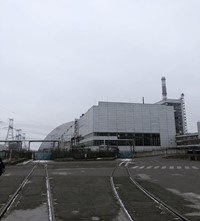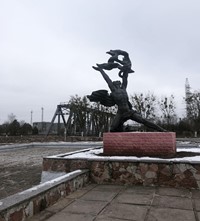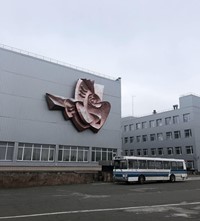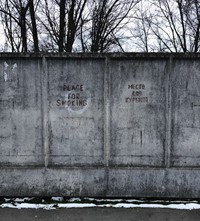Tom Connick travels to Ukraine for the launch of the first ever art installation at the site of the infamous nuclear reactor explosion
- TextTom Connick
Few destinations garner reactions quite like Chernobyl. The site of the infamous nuclear reactor explosion in April 1986 (the power station itself), as well as the surrounding, largely abandoned area known as the ‘nuclear exclusion zone,’ is an intrinsic part of cultural and political lore. Once a marker of Soviet rule, in the 30-plus years since the incident, the station and its neighbouring (and also abandoned) city Pripyat have become inspiration for everything from Call Of Duty videogames to post-apocalyptic horror films.
Given the cultural levity applied to Chernobyl – whether as an inspiration for filmmakers, or a case study for politicians and pressure groups across the world – it’s easy to forget the very real implications of the explosion which is thought to be linked to anything from 40,000 to upwards of a million cancer diagnoses, depending on which study you read.
Now, though, it’s inspired an artistic first: Artefact, a “contemporary art and media project” by Kiev-based artist Valery Korshunov, which launched in Pripyat just last month. Touted as the first ever art installation to take place within the confines of the nuclear exclusion zone, Artefact combines “digital sculpture, activism, music, VJing, light art and artificial intelligence of the internet,” in order to provide an “answer of art to continuous problem of digitalisation and general overload of information space, the dominance of fake news, and the low level of media literacy of the population.”
I travelled to Chernobyl and Pripyat to check it out – here, I share my minute-by-minute thoughts on the journey through the infamous nuclear exclusion zone, and whether the transformation of Pripyat into a gallery pays enough respect to the site of such a catastrophic disaster.
9:36am: An hour behind schedule, we’re on a minibus out of Kiev. What the bus might lack in adequate heating and suspension, it more than makes up for in views. Following the 2014 revolution, Kiev is a city in flux, which is more than apparent as we drive out of it – the edges of the town appear to be endlessly expanding, new builds and scaffolding stretching far outside of the city centre.
10:46am: Finally, free of the sprawl of building sites that surround Kiev’s centre, we’re out in the Ukrainian wilderness. The temperature drops far below freezing – forecasts today are promising minus seven Celsius. As we drive through barren pine forest after barren pine forest, we’re assured such cold is unseasonal.
11:14am: Without ceremony, we approach the edge of the 30km nuclear exclusion zone, and are hurriedly shepherded out into the cold. I very quickly regret my lack of layers. Next to where the bus is parked is the first of surely many disconcerting sights to come – a gift shop and ‘tourist information centre’. Mugs, t-shirts, even teddy bears come adorned with the lurid yellow radiation symbol. Stray dogs, meanwhile, pad about the place, excitedly skipping over to the new arrivals as we join the queue for an army-manned passport checkpoint. Dogs, I learn, abound in the nuclear exclusion zone because evacuees were not allowed to take their pets with them. As a result, the dogs took over the abandoned towns, breeding amongst themselves. Given the three decades of wild living, I’m taken aback by their friendliness.
11:31am: Reaching the front of the queue, our passports are checked by Ukrainian army officials. Stepping across the barrier and into the nuclear exclusion zone, I’m immediately hit by how deserted the road ahead is.

11:42am: Back on the bus, we enter the exclusion zone proper. A police escort takes us down a long, straight road that stretches far beyond the horizon, flanked on either side by completely barren, snow-tipped pine forests. Again, the isolation is notable.
11:51am: We cross a road bridge that is, oddly, covered in completely untouched snow; the river below it frozen solid on top. As we reach the other side, empty farmhouses begin to pop up by the side of the road. The rooves of some have fallen in completely – others are simply hollow shells of what the once were. Signs dating back to the 80s warn of the dangers of forest fires; they’re worn around the edges, but the grim irony of their message is still legible.
11:58am: Those farmhouses become empty suburbs, trees filling every space where once were roads and gardens. It’s the first real gut-punch moment – the eeriness of abandoned homes, gardens and streets, with nature overtaking the lot, is like nothing I’ve ever experienced.
12:02pm: Without warning, we enter an area that’s semi-populated, cars and pedestrians beginning to pop up. I’m reminded by a companion that some have re-entered the city unofficially and against government orders; others, meanwhile, still work on the remaining reactors of the nuclear station. Regardless of what they’re here for, the tour bus convoy gets disapproving looks from those outside it. I can’t help but feel somewhat voyeuristic. I wonder how they’d feel about the gift shop.
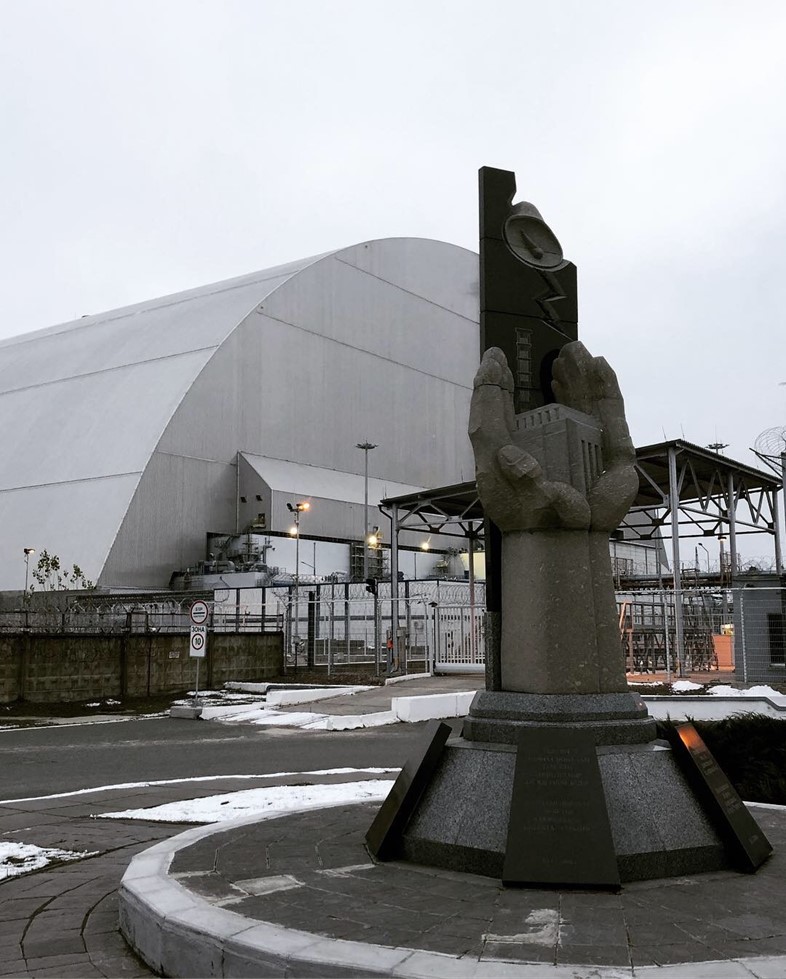
12:15pm: The ‘sarcophagus’ which has been built over the exploded reactor appears on the horizon, and we turn into Chernobyl. The drainage system around the station is completely frozen over – from this side, it looks more like a moat. A family of ducks swims through a patch that has thawed, and I’m reminded of the horror stories of the supposedly-radiated animals that supposedly populate the pond – videos of catfish the size of small cars can be found on YouTube.
12:31pm: The convoy has pulled in alongside the Statue of Prometheus – a monument erected a stone’s throw from the sarcophagus itself. It seems appropriate, given that, in Ancient Greek lore, Prometheus is punished by Zeus for stealing fire from Mount Olympus and gifting it to humans. It’s an allegory for scientific overreaching that Chernobyl has become known for.
12:40pm: Speakers from Ukranian government join Artefact artist Valery Korshunov in introducing the work. “This is a territory associated with grief. We have come here to change our history,” says Svetlana Korshunova, the event’s curator. “We are grateful to you for coming, and for believing us. The Zone is safe. We are here to make this place better, and to change the face of Chernobyl.” The term ‘fake news’ gets dropped into the conversation by Korshunov. While it feels a little heavy-handed at first, he explains that the inspiration came from the Soviet Union’s response to the Chernobyl disaster, and how the citizens of Pripyat and beyond were lied to about the reality of the incident.
13:38pm: We’re driven out to the DGRU “Arc”, a structure designed and built by the Soviet Union to detect incoming missiles during the Cold War. Built two years before the explosion, it was never turned on for more than minor calibrations. It cost three times as much as the atomic station itself – some conspiracy theorists claim the incident at Chernobyl was orchestrated in order to distract attention from the Arc’s real purpose.
14:00pm: Standing under the Arc, I’m blown away by the sheer scale of it. Others nearby send up drones to capture footage from the top, while I walk the full 300m span of the detector. Before long, another domesticated stray dog pops out of the woods. It walks right alongside me for the full half-mile walk back to the bus.
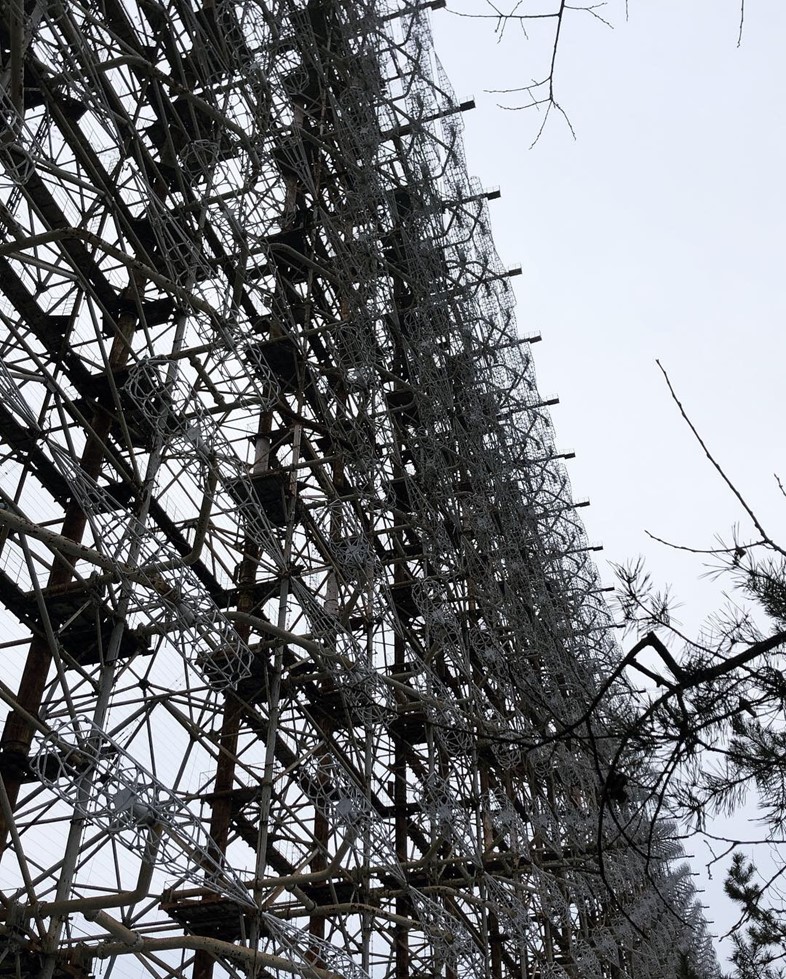
14:38pm: We head back to Chernobyl for lunch, as a soldier stands up at the front of the bus. He tells us that we cannot eat anything that grows here, lives here, or any fish in the water, because it will cause skin irritation. When we arrive at lunch 20 minutes later, we have to go through a radiation scanner before we’re allowed to enter the dining hall. My appetite has dipped, somewhat.
15:05pm: Lunch is served in true Soviet style. Our guide points out how typically Soviet the dining hall’s stark, white, functional decor is, while the food itself consists of plain chicken, plain rice, and borscht – a thin, bitter, luminous red (but not unpleasant) beetroot soup, which I’m told is traditional Ukrainian fare.
16:10pm: Once fed, we drive right up to the Sarcophagus. Right by its checkpoint entrance, a commemorative statue pointing to the incident has been erected – we’re warned that it’s the most radioactive part of the entire exclusion zone. It’s an eerie location, and one that I don’t want to linger around too long – the silence still pervades even here in the heart of the station, while the looming, 31,000 tonne structure itself feels ominous. As we leave, with the sun going down and Pripyat itself our next destination, protective medical suits are handed down the bus. “It is for your protection from… I don’t know what,” smirks our guide.
16:26pm: We drive past a sign commemorating the opening of Pripyat in 1970. There are fresh flowers and wreaths placed at its base.
16:27pm: We are told to put our suits on – there’s a slight sense of panic as everyone on the bus grabs them hurriedly. We are told not to take anything from the town.
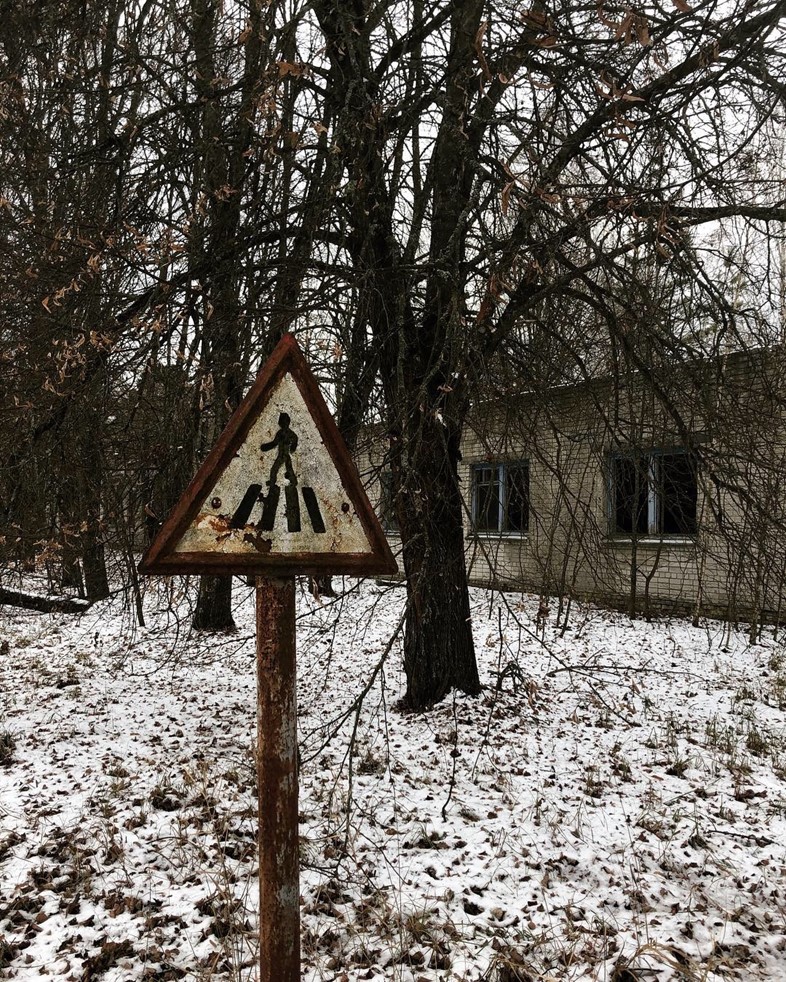
16:30pm: “We are now entering Pripyat town. Nobody lives here,” announces our military escort, clearly enjoying hamming it up somewhat. He needn’t have bothered – as we enter the town gates, a weathered crucifix sits at the entrance to Pripyat.
16:33pm: The town is completely desolate - trees and roots snake through every patch of ground. Tower blocks lay empty, looking skeletal without any light or the general decoration of inhabitants – though I’m informed that, were you to enter them, clothes would still be hanging in wardrobes, and food still filling shelves and cupboards. Evacuees were told they would be able to return within 36 hours. 32 years on, the city still sits empty.
16:42pm: From around a seemingly pitch-black corner, the Ferris wheel of Pripyat’s infamous amusement park rears its head. Immortalised in videogames and movies alike (“I feel like I’m on a film set,” remarks one of my companions), it’s impossibly haunting in full, rusted reality. Another member of the tour party pulls at the carousel next to us, leaving it to spin on its axis with a blood-curdling screech.
16:50pm: A soldier holds a Geiger counter to a manhole. It reads 36 – I’m reminded of earlier in the afternoon, when I was told anything over 40 is “bad news”. I pick up the pace somewhat.
17:00pm: Entering the Artefact site, I’m immediately struck by the object itself. A giant, shimmering star, dangling from a crane and flanked by two huge screens, it feels a little like something you might stumble upon at Glastonbury’s South East corner.

17:10: As the Artefact installation begins to whir into life, a soundtrack of ambient techno and a light-show defined by oscillating lasers bouncing off the buildings around us, that ‘Glastonbury at 4am’ feeling amps up somewhat.
17:21: The Artefact show itself offers up largely abstract notions of technological advancement and human form, all of which are projected onto the two huge screens either side of the main star structure. I’m struck, somewhat, by the irony of a piece denouncing media illiteracy being somewhat difficult to read. Andrei Tarkovsky’s Stalker, the 1979 Russian film, which many point to as having predicted the Chernobyl incident, is referenced throughout. As those lights continue to jar with the dust-covered Soviet structures around us, I remember the abruptly-paused lives that still sit dormant within them.
17:40: Back on the bus for a final time, driving once more through the abandoned centre of Pripyat, I’ve an uneasy, conflicted feeling surrounding Artefact. The ceremony of its unveiling, and the techno-heavy show itself, seemed to gloss over the human element of the town. Turning what should perhaps be a monument to a modern catastrophe into the site of a dance party doesn’t sit well.
18:00: The juxtaposition between the hubris of today’s unveiling and the human reaction to the event itself is driven home as my companion shows me a message he’s received from a Russian friend. “That thing killed my grandmother…” she’s replied to an Instagram Story of the Sarcophagus.
18:30: We’re shepherded back through passport control, via the gift shop once more. Mulled wine sits bubbling away, in a vat adorned with that yellow atomic symbol. I’ll pass, I think.
